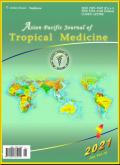继发性葡萄球菌和克雷伯氏菌感染的非典型脓包表现在发病前Ebstein异常患者:1例报告
IF 1.6
4区 医学
Q3 PUBLIC, ENVIRONMENTAL & OCCUPATIONAL HEALTH
引用次数: 0
摘要
理由:丘疹是指主要分布在手掌和手指侧面的瘙痒性小泡或大疱性皮疹。它在亚洲人中不太常见,在严重的情况下,可能会发生绒球的继发性细菌感染,并导致疼痛、肿胀和脓疱。患者担忧:一名15岁女孩抱怨她的手和脚上有6个多月的渐进性伤口和含有黄色脓液和硬皮的小肿块,并在入院前的最后一个月恶化。她也有Ebstein异常。诊断:非典型绒球炎伴继发性葡萄球菌和克雷伯氏菌感染。干预措施:用湿敷料护理伤口,在结壳上涂抹保湿霜,对革兰氏阳性菌和阴性菌使用抗生素,并在计算适当热量的情况下提供营养支持。结果:皮肤损伤完全愈合,患者在住院10天后出院。经验教训:绒球炎的非典型表现使其难以诊断。诊断可以通过仔细的病史和身体检查来确认。伤口护理和控制感染应该得到一个最佳的结果。本文章由计算机程序翻译,如有差异,请以英文原文为准。
Atypical pompholyx presentation of secondary Staphyloccoccus and Klebsiella infections in a patient with premorbid Ebstein anomaly: A case report
Rationale: Pompholyx refers to pruritic vesicles or bullous rash that mainly distribute on the palms and lateral surfaces of the fingers. It is less common among Asians, and in a severe condition, secondary bacterial infection of pompholyx can happen and result in pain, swelling and pustules. Patient concerns: A 15-year-old girl complained of progressive wound and small bumps containing yellowish pus and crusts on her hands and feet for over 6 months and worsened in the last month before admission. She also had Ebstein anomaly. Diagnosis: Atypical pompholyx with secondary Staphylococcus and Klebsiella infections. Interventions: Wound care with wet dressing and applying moisturizer on crusts, application of antibiotics for Gram positive and negative bacteria and giving nutritional support with reckoning of proper calories. Outcomes: Skin lesions were completely healed and the patient was discharged after 10 days of hospitalization. Lessons: Atypical manifestation of pompholyx makes it hard to diagnose. The diagnosis can be confirmed with meticulous history-taking and physical examination. Wound caring and controlling of the infection should be done to earn an optimal outcome.
求助全文
通过发布文献求助,成功后即可免费获取论文全文。
去求助
来源期刊

Asian Pacific journal of tropical medicine
PUBLIC, ENVIRONMENTAL & OCCUPATIONAL HEALTH-TROPICAL MEDICINE
CiteScore
4.00
自引率
9.70%
发文量
1936
审稿时长
3-8 weeks
期刊介绍:
Asian Pacific Journal of Tropical Medicine (ISSN 1995-7645 CODEN: APJTB6), a publication of Editorial office of Hainan Medical University,is a peer-reviewed print + online Monthly journal. The journal''s full text is available online at http://www.apjtm.org/. The journal allows free access (Open Access) to its contents and permits authors to self-archive final accepted version of the articles on any OAI-compliant institutional / subject-based repository.
APJTM aims to provide an academic communicating platform for international physicians, medical scientists, allied health scientists and public health workers, especially those of the Asia-Pacific region and worldwide on tropical medicine, infectious diseases and public health, and to meet the growing challenges of understanding, preventing and controlling the dramatic global emergence and re-emergence of infectious diseases in the Asia-Pacific.
The journal is proud to have an international and diverse editorial board that will assist and facilitate the publication of articles that reflect a global view on tropical medicine, infectious diseases and public health, as well as emphasizing our focus on supporting the needs of public health practitioners. The APJTM will allow us to seek opportunities to work with others who share our aim, and to enhance our work through partnership, and to uphold the standards of our profession and contribute to its advancement.
 求助内容:
求助内容: 应助结果提醒方式:
应助结果提醒方式:


